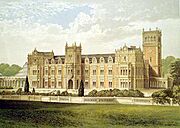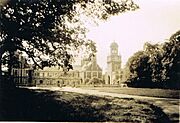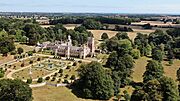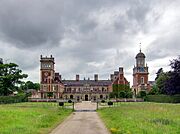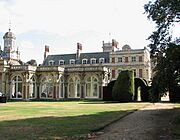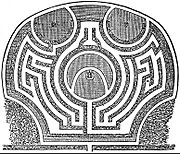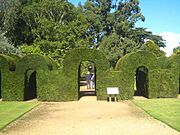Somerleyton Hall facts for kids
Quick facts for kids Somerleyton Hall |
|
|---|---|

The garden front
|
|
| Type | Country house |
| Location | Somerleyton, Suffolk, England |
| Built | Early modern period |
| Rebuilt | 1840s |
| Architect | John Thomas (1840s) |
| Architectural style(s) | Jacobean and Italianate |
| Owner | Hugh Crossley, 4th Baron Somerleyton |
|
Listed Building – Grade II*
|
|
| Official name: Somerleyton Hall | |
| Designated | 29 January 1987 |
| Reference no. | 1198046 |
|
Listed Building – Grade II*
|
|
| Official name: Stable Court to Somerleyton Hall | |
| Designated | 29 January 1987 |
| Reference no. | 1352646 |
|
Listed Building – Grade II*
|
|
| Official name: Kitchen Garden of Somerleyton Hall | |
| Designated | 29 January 1987 |
| Reference no. | 1031936 |
|
Listed Building – Grade II
|
|
| Official name: Remains of Winter Garden of Somerleyton Hall | |
| Designated | 29 January 1987 |
| Reference no. | 1031930 |
| Official name: Somerleyton Park | |
| Designated | 29 January 1987 |
| Reference no. | 1000188 |
| Lua error in Module:Location_map at line 420: attempt to index field 'wikibase' (a nil value). | |
Somerleyton Hall is a large country house and estate in Suffolk, England. It covers about 5,000 acres (about 20 square kilometers). The hall and its beautiful gardens are very important historically. They are protected as 'Grade II* listed' sites. This means they are special buildings and gardens that must be preserved.
The current owner is Hugh Crossley, 4th Baron Somerleyton. He lives there with his family. The formal gardens alone are huge, covering 12 acres (about 4.8 hectares). Lord Somerleyton is also working on a project to bring nature back to 1,000 acres (about 400 hectares) of the estate. This is called 'rewilding'. He has brought in free-roaming cattle, large black pigs, and Exmoor ponies to help the land return to a more natural state.
Contents
History of Somerleyton Hall
Early Owners and Changes
In 1240, a manor house was first built on this site. It was built by Sir Peter Fitzosbert. His daughter later married into the Jernegan family. The Jernegans owned the estate until 1604.
At that time, John Wentworth bought the estate. He made big changes to the main house. He turned it into a grand East Anglian Tudor-Jacobean mansion. After him, the Garney family owned the property.
Admiral Sir Thomas Allin
The next owner was Admiral Sir Thomas Allin. He was from a nearby town called Lowestoft. Admiral Allin was a brave naval officer. He took part in important sea battles, like the Battle of Lowestoft in 1665 and the Battle of Solebay in 1672. Eventually, his family line also ended.
Samuel Morton Peto's Vision
In 1843, the Somerleyton estate was bought by Samuel Morton Peto. He was a very successful businessman and a Member of Parliament. For the next seven years, he worked hard to rebuild the hall. He created an amazing Anglo-Italian architectural masterpiece.
Peto also had special paintings made for the house. He completely redesigned the gardens and grounds. Famous garden designers like William Andrews Nesfield and Joseph Paxton helped him. Paxton also designed The Crystal Palace. Peto's son, Harold Peto, later became a well-known garden designer himself.
The Crossley Family Era
In 1863, the estate was sold to Sir Francis Crossley. He was a carpet manufacturer from Halifax. Like Peto, Sir Francis was a kind person who gave a lot to charity. He was also a Member of Parliament.
Sir Francis' son, Savile, was given the title of Baron Somerleyton in 1916. The family's motto is 'Everything that is good comes from above'. Hugh Crossley, 4th Baron Somerleyton, inherited the hall in 2012. He lives there with his family today.
Hovercraft Experiments
An interesting fact about Somerleyton Hall is that its lake was used for early experiments. In 1955, Christopher Cockerell, who invented the hovercraft, tested his ideas there.
Exploring Somerleyton Hall
The Hall Building
The main hall building is a Grade II* listed building. This means it is a very important historic building. It was designed by John Thomas, an architect who had worked for Prince Albert. The hall was finished in 1850. The clock tower at the hall has a clock designed by Benjamin Vulliamy, a famous clockmaker.
Beautiful Formal Gardens
The landscaped park and formal gardens are also very important. They are Grade II* listed on the Register of Historic Parks and Gardens. The formal gardens cover 12 acres (about 4.8 hectares). They are part of the much larger 5,000-acre (about 20 square kilometer) estate.
A special feature is the yew hedge maze. It is one of the best in Britain and was created by William Andrews Nesfield in 1846. There is also a unique greenhouse designed by Joseph Paxton. This is the same architect who designed The Crystal Palace.
The gardens also have a walled garden, an aviary (for birds), and a loggia (an open-sided gallery). There is a 90-meter (about 295-foot) long pergola covered with beautiful roses and wisteria. In other parts of the garden, you can find rhododendrons and azaleas. There are also many impressive specimen trees.
Several other parts of the gardens are also listed as historic. These include the kitchen garden, the stable court, and various statues and ornaments.
The Estate and Rewilding
The Somerleyton estate covers 5,000 acres (about 20 square kilometers). Lord Somerleyton was inspired by Knepp Wildland. This is a successful rewilding project started by Sir Charles Burrell, 10th Baronet in West Sussex.
Somerleyton has fenced off 1,000 acres (about 400 hectares) of its estate for rewilding. They have brought in large black pigs, Exmoor ponies, and 100 free-roaming cattle. The plan is to expand this project to include the 150-acre (about 60-hectare) Fritton Lake and 600 acres (about 240 hectares) of Suffolk Sandlings. Somerleyton is also a founding trustee of WildEast. This is a charity that promotes natural farming and rewilding in East Anglia.
Gallery
See also
 In Spanish: Somerleyton Hall para niños
In Spanish: Somerleyton Hall para niños


